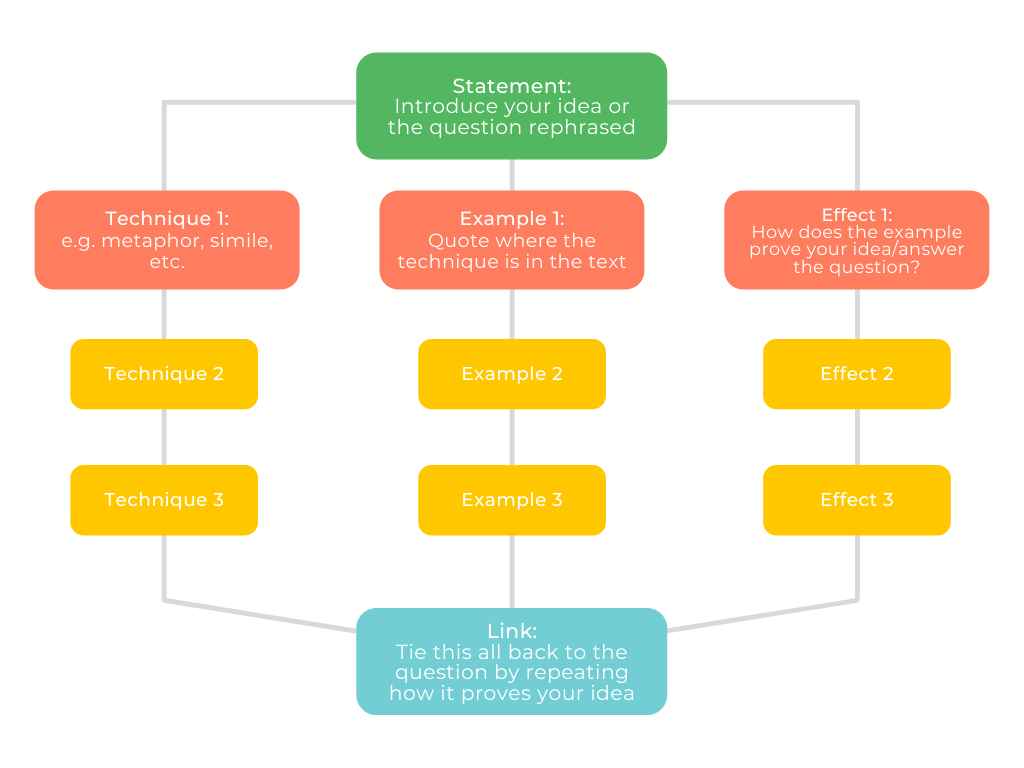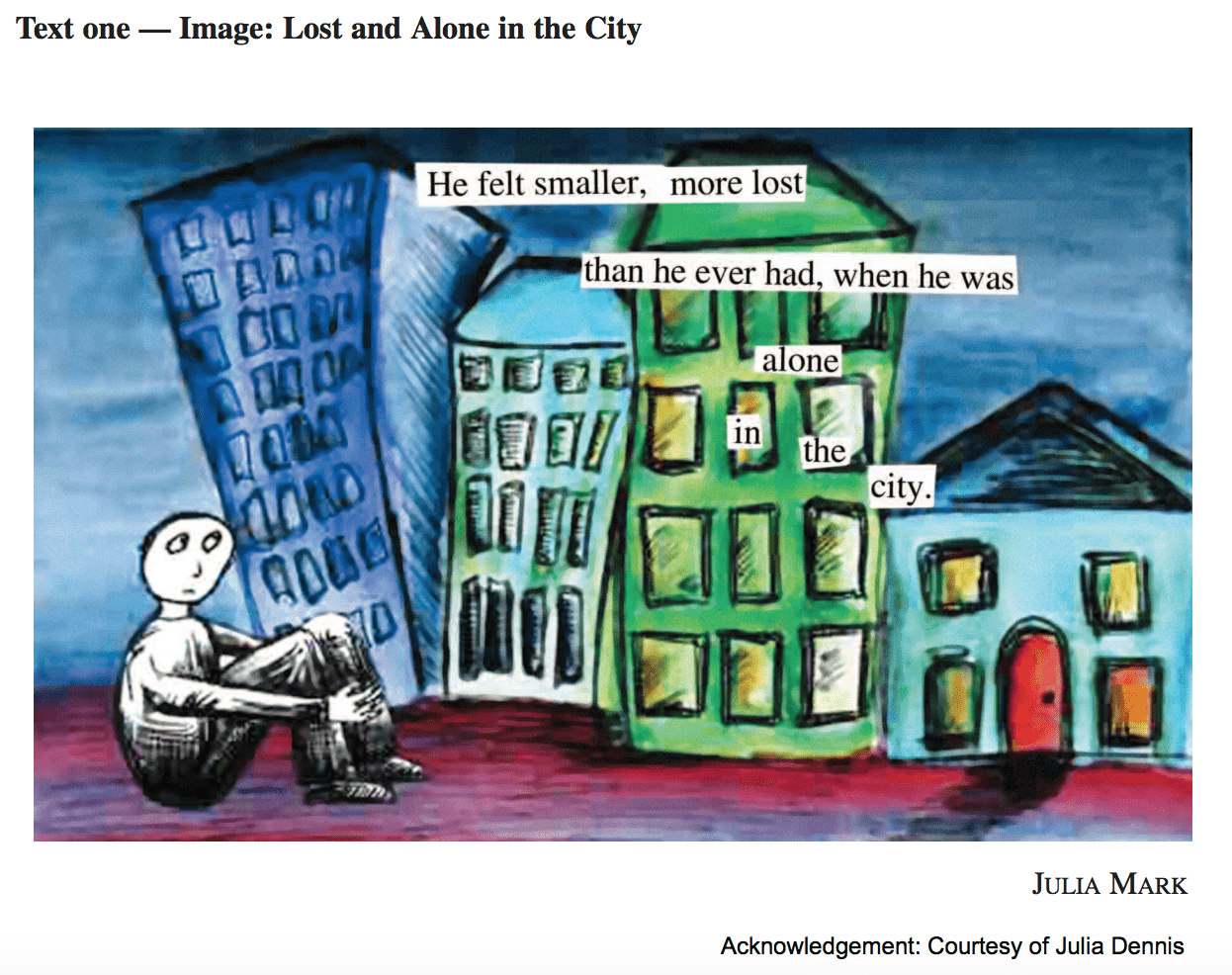
Analysing visual texts are generally one of the most confusing and panic-inducing things you can face in the first section of your HSC English exam.
Not because they’re actually any harder — in fact, it’s usually quicker to analyse them than written texts — but because you have to analyse them in a different way!
By breaking down the process into 3 simple steps, you can be writing awesome visual text analyses in no time.
All you have to do is figure out what you’re looking at, what you’re looking for and how to structure your answer. I promise it’s easier than it sounds.
So read on and let’s get visual with this awesome Guide to Analysing Visual Texts for HSC English!
What is a Visual Text?
Step 1: Identify Visual Techniques
Step 2: Read the Question and Break it Down
Step 3: Use the STEEL Structure
What is a Visual Text?
A ‘visual text’ is usually just a fancy way of saying ‘an image’ when it’s related to English and analysing texts.
Basically it means that whatever you’re analysing is a visual medium — think book covers, picture books, posters or still frames from movies!
Want an example of how to analyse a film? Check out our summary of Amélie for tips!
Usually the first section of your HSC English paper will contain at least one visual text, so it’s important to know how to analyse and respond to it.
In this article we’ll work through a past paper question based on a visual text — unfortunately it’s focussed on an old Area of Study (Belonging) but the skills we’re teaching remain the same!
Reach out to our Sydney HSC English tutors if you would like individual support in analysing Visual Texts for HSC English and achieve on average a 20%+ mark improvement for HSC English.
We’ll be focussing on the visual text above and the question below.
Step 1: Identify Visual Techniques
The first and most important step is to look at the visual text you’re going to be analysing – that’s pretty obvious. Because looking at images takes so much less time than reading a text however, this is also when you should identify your visual techniques.
You heard right — start looking for visual techniques right away!
The kind of techniques you’re looking for are things like;
- Colour
- Lighting
- Vectors
- Costuming
- Gaze
- Salience
We’ve got a more comprehensive list of visual techniques if you need to brush up on them!
The best way to pick these out in a visual text is to look at what your eyes are immediately drawn to and figure out why. Is it because there’s one patch of blue in an orange image? Or maybe one figure is way bigger than another?
Label each of these techniques and then annotate them with a few words about what effect the technique is having.
For example, if an image is mainly yellow, write something like “Colour – yellow has happy connotations, creates joyful mood”. It’s that simple!
It seems a little odd to look for techniques before you’ve even looked closely at the question, but this actually helps you in the long run.
By finding a whole bunch of visual techniques right off the bat you’re able to go into your question feeling more prepared, and immediately pick out which techniques will suit the response you plan to write.
If you read the question first you may end up trying to find a specific technique you want to talk about even if it’s not there.
For example, if the question asks about the mood of the image, you may immediately think to yourself “Oh, lighting helps create mood, I’ll talk about lighting!”.
The problem is that, even though it’s a good technique to use, the visual text you’re looking at may not actually have a good example of that technique!
Therefore it’s better to find some strong techniques and fit them to the question, rather than trying to make the question fit to weaker techniques.
Our example has a few really obvious visual techniques as well as some subtler ones we can pick out.
1. Colour contrast – black and white figure contrasts with colour background, symbolic of ‘grey’ mood and not fitting in
2. Gaze – offer gaze, creates a vector from the character’s eyes to the text, encourages audience to read the words
3. Text – symbolically appears ‘cut-out’ and disjointed, word connotations of “smaller”, “lost” and “alone”
4. Colour – the whole image is in rich, saturated colours to better contrast the black and white figure
5. Angles – the buildings/houses all appear at different angles, creating a sense of being off-kilter or unbalanced
While we can’t run straight into writing our response yet, this quick critical look at the text has already given us a whole bunch of techniques to analyse later — as well as marking exactly where they are in the image and what they’re doing!
Step 2: Read the Question and Break it Down
Now’s the time to figure out what you’re being asked about the visual text!
Because you’ve already got a whole bunch of visual techniques jotted down, it’s easy to start planning out an answer right when you read the question — or at least choose the technique you’ll focus on!
It’s usually best to break down the question into its individual key words and phrases to figure out exactly what the markers are looking for.
This is the same as breaking down English questions for written texts, and because the questions are in the short answer section of the HSC paper they’ll usually have fewer parts!
Once you’ve broken it down you’ll be able to figure out exactly which techniques from earlier best suit the question, so it’s a good idea to jot them down too.
Maybe even update your annotations to make it clear how you’re going to link the technique to the question being asked.
We’ll break down a question in the example, but we’ve also got a more in-depth guide to breaking down English questions.
Going through the question and highlighting the key words makes it really easy to pick out just what you need to comment on in your answer!
It also tells you what kind of techniques you’re going to want to be analysing in order to answer the question.
Having identified key points, let’s break down what each one means:
Analyse: The markers are looking for you to use techniques from the text to break down what the text is actually saying. The best way to tackle the example is by using the ‘TEE’ method to show how the text represents an overall idea.
Portray: Portray is basically the fancy way of saying ‘show’! This means that we want to be looking at specific examples from the text – our techniques – and how they show something (the complex emotions/desire for connection).
Complex emotions: The markers want you to think of emotions in a more sophisticated way – instead of just saying “he’s sad” think about why he’s sad, how we know that he’s sad, etc. Also try to think of other emotions that a character may be feeling and how they conflict. Maybe a character is happy but also nervous, or sad but also relieved? These are things to consider when thinking about “complex” emotions.
Desire for connection: This is what our complex emotions should be about! Make sure that all the emotions you talk about link back to a character wanted to ‘connect’ or belong in some way, and talk about how the text shows that (visual techniques).
Now to choose our best 3 techniques to focus on in our response!
Colour contrast – black and white figure contrasts with colour background, symbolic of ‘grey’ mood and not fitting in. Shows that character is aware of their lack of connection and is saddened by it.
Text – symbolically appears ‘cut-out’ and disjointed, word connotations of “smaller”, “lost” and “alone”. Emphasises character’s lack of connection and the negative impact his desire for connection has on his emotions.
Colour – the whole image is in rich, saturated colours to better contrast the black and white figure. Shows the ‘outside’ as bright and happy, making it clear that the character would desire to be connected with it and enjoy more positive emotions.
Step 3: Use the STEEL Structure
By now your teachers have probably drilled the STEEL format into your brain a thousand times over, but here’s a reminder of what the acronym means just in case.
S: Statement
T: Technique
E: Example
E: Effect
L: Link
Short answer questions like the ones you’ll be getting on visual texts don’t need to follow the STEEL method as strictly, though it’s good to still try to keep it in mind. An edited ‘short-answer STEEL’ like the one below is a great way to keep your answer short but structured:

You’ll want to try to repeat the TEE section once for each technique, so three times all up, but only have one statement and link.
This way your response will be structured and contain all the information you want to get across without it taking 20 minutes to write! Remember, these are short answer questions so you don’t need to go into too much detail.
For example:
“The complex emotions resulting from a desire for connection is effectively portrayed in text one through its use of contrast, text and colour.
The figure in the lower left corner of the image is the most salient feature, his black and white colouring creating a high contrast with the otherwise colourful background. This choice of colour to greyscale contrast creates an immediate sense that the character lacks a connection to the world around him, which results in his own sadness or ‘grey’ mood. The text in the upper right confirms this, not only through the negative connotations of words such as “smaller”, “lost” and “alone”, but also through its stylisation as ‘cut out’ fragments. This emphasises the sense of disjointedness and disconnection borne of lacking connection and reinforces the character’s emotions of isolation and melancholy. Finally, the colour used in the rest of the image is rich and vibrant, a clear choice made to present the ‘outside world’ as desirable and full of colour. This prompts the audience to consider that the character clearly desires connections with this world, but seems reluctant to make them. This reveals a more complex emotional situation as he seems to actively choose to remain isolated, perhaps out of fear of rejection.
Overall the image presents a complex insight into how a desire for connection can result in complex emotions, as the character seems to both desire connections and actively avoid them. Thus it is through contrast, text and colour that text one effectively portrays how complex emotions can result from a desire for connection.”
And it’s done — one amazing response to a visual text question!
Now it’s time for you to try analysing visual texts!
Now it’s time to give it a go! This article has shown you exactly how to smash out an awesome response, so get writing.
The end goal is to be able to do these steps in your head, but that only comes with practice and actually doing all the steps on paper — it’ll make it all so much easier to repeat in test conditions!
Check out our master list of HSC English past papers to get some practice with analysing visual texts! You can also check out our FAQs for HSC English for more info.
Looking for extra help with analysing visual texts for HSC English?
We pride ourselves on our inspirational HSC English coaches and mentors!
We offer tutoring and mentoring for Years K-12 in a variety of subjects, with personalised lessons conducted one-on-one in your home or at one of our state of the art campuses in Hornsby or the Hills!
To find out more and get started with an inspirational tutor and mentor get in touch today!
Give us a ring on 1300 267 888, email us at [email protected] or check us out on TikTok!
Maddison Leach completed her HSC in 2014, achieving an ATAR of 98.00 and Band 6 in all her subjects. She enjoys helping students through the academic and other aspects of school life, even though it sometimes makes her feel old. Maddison has had a passion for writing since her early teens, having had several short stories published before joining the world of blogging. She’s currently studying a Bachelor of Design at the University of Technology Sydney and spends most of her time trying not to get caught sketching people on trains.







